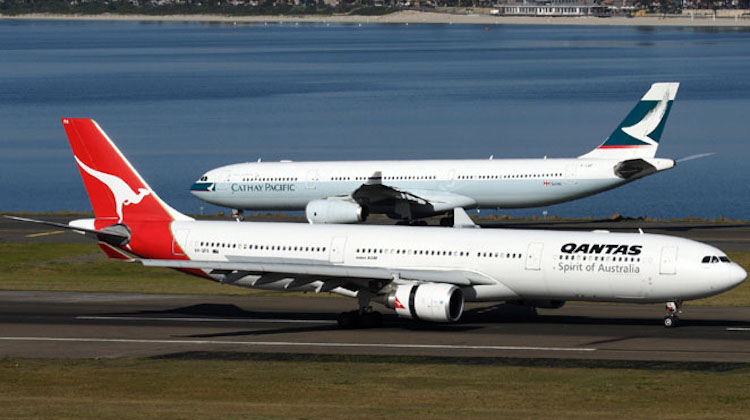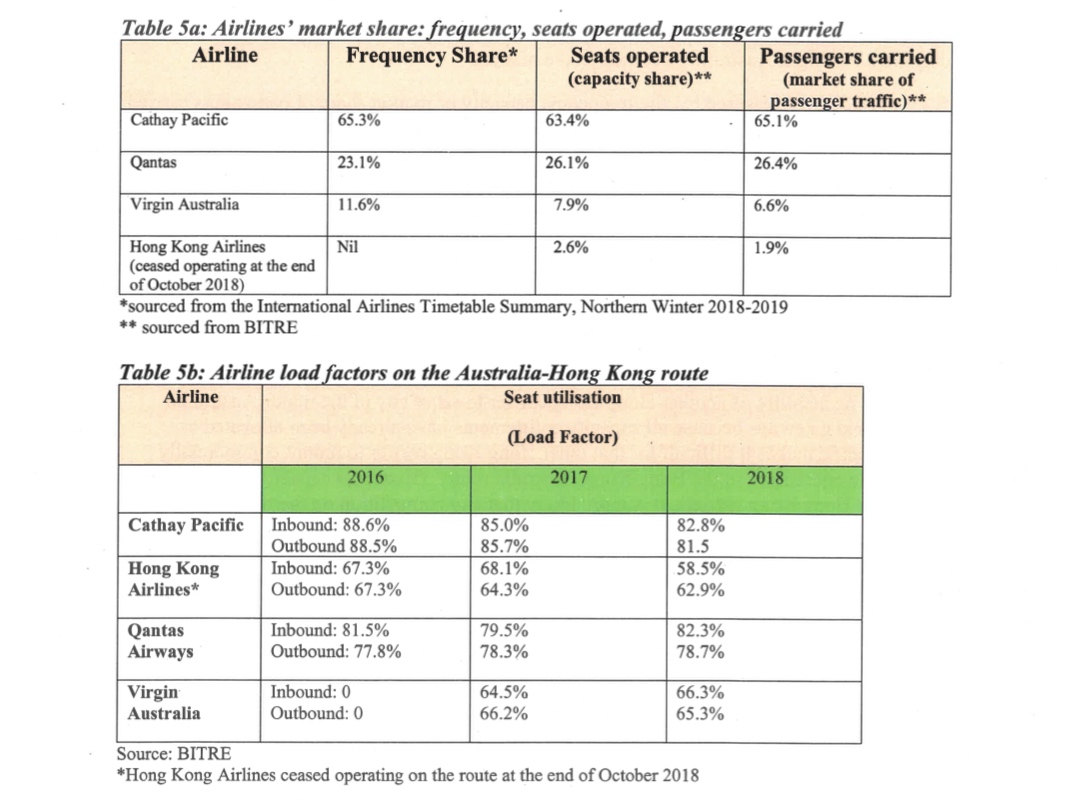
Qantas says it is disappointed at being denied the opportunity to forge a deeper partnership with Cathay Pacific.
Australia’s International Air Services Commission (IASC) said on Tuesday it had rejected Qantas’s application for Cathay Pacific to add its CX airline code on 35 flights a week between Australia and Hong Kong.
The final ruling followed the IASC’s draft decision to knock back the application in May.
“We’re disappointed with the decision to reject our application to expand our codeshare with Cathay Pacific,” Qantas said in a statement to Australian Aviation on Tuesday.
“We are reviewing the decision and are considering our next steps.”
In early 2019, Qantas sought regulatory approval for Cathay Pacific to add its CX airline code on 35 Qantas-operated flights a week across three routes – Brisbane-Hong Kong, Melbourne-Hong Kong an Sydney-Hong Kong.
The codeshare flights on these routes would only be sold as part of a through journey involving connections either beyond Hong Kong on Cathay Pacific or its regional wing Cathay Dragon to destinations in India, Sri Lanka and Vietnam, among other countries, or to other Australian domestic destinations from Brisbane, Melbourne and Sydney on Qantas.
Qantas also planned to add its QF airline code on 35 Cathay Pacific-operated flights a week from the same three Australian cities and Hong Kong. However, this did not require regulatory approval.
The proposed codeshare flights are shown in bold in the table below:
Flight Number/Routing |
Qantas flights |
Cathay Pacific flights |
|
Brisbane-Hong Kong |
QF97 10:10–17:25 |
CX156 00:55 – 07:30 |
|
Hong Kong-Brisbane |
QF98 20:15 – 07:00+1 |
CX157 13:10 – 23:35 |
|
Melbourne-Hong Kong |
QF29 09:40 – 17:20 |
CX134 07:30 – 15:05 |
|
Hong Kong-Melbourne |
QF30 20:10 – 07:35+1 |
CX105 00:10 – 11:10 |
|
Sydney-Hong Kong |
QF127 10:20 – 18:00 |
CX110 07:35 – 15:20 |
|
Hong Kong-Sydney |
QF128 19:30 – 06:55+1 |
CX139 09:10 – 20:20 |
Source: Qantas
The proposed codeshare would have expanded an existing arrangement that has been in place since late 2018, where Qantas added its QF airline code on selected Cathay Pacific/Cathay Dragon flights out of Hong Kong – as well as on Perth-Hong Kong and Cairns-Hong Kong, and Cathay Pacific added its CX airline code on selected Qantas Australian domestic flights.
“The codeshare has already delivered great benefits for our customers and expanding it would create even more options for travellers and improve opportunities for frequent flyers,” Qantas said.
While Qantas described the proposed codeshare as “a pro-competitive expansion of each carrier’s ability to sell and market itineraries” that was focused on attracting connecting passengers, the IASC disagreed.
The IASC final decision said the proposed codeshare “would entrench the dominant positions of Qantas and Cathay Pacific as the two largest airlines offering direct services on the route” and weaken the competitive position of Virgin Australia, the only other carrier offering nonstop flights between Australia and Hong Kong.
“The commission considers that this further entrenched position is likely to impair other carriers’ ability to enter into and offer commercially sustainable services on the route,” the IASC final ruling said.
“The public interest is best served by having a healthy number of competing carriers on the route, each with a sustainable level of capacity.”
Virgin Australia, which strongly opposed the proposed codeshare in its submissions to the IASC, welcomed the final decision.
The airline said the ruling would ensure there would be no distortion in the competitive landscape on the Australia-Hong Kong route.
“The proposed codeshare would have constrained the ability for other players to effectively compete on this route, which would have had a negative flow-on effect for our customers, as well as impacting tourism and trade,” Virgin Australia said in a statement to Australian Aviation on Tuesday.
“Hong Kong remains an important part of our international network and we will continue to offer an exceptional product and service for the travelling public.”

Cathay Pacific, Qantas and Virgin Australia the only three airlines with nonstop Australia-Hong Kong flights
Currently, Cathay Pacific serves six destinations in Australia – Adelaide, Brisbane, Cairns, Melbourne, Perth and Sydney – from its Hong Kong hub with a mix of Airbus A330-300s, A350-900s and Boeing 777-300ERs offering business, premium economy and economy. This does not include freighter services. Cairns flights are ending in October.
It planned to use the A350-1000 to Melbourne and Perth from October.
Cathay Pacific is the only Hong Kong-based carrier offering nonstop flights to Australia, after Virgin Australia alliance partner Hong Kong Airlines withdrew its flights to Cairns and the Gold Coast in October 2018.
Qantas offers nonstop flights from Brisbane, Melbourne and Sydney to Hong Kong with a mix of Airbus A330s, A380s and Boeing 747s and 787-9s.
Virgin Australia started serving the Special Administrative Region (SAR) with its own aircraft in July 2017, when it began nonstop flights on the Melbourne-Hong Kong route with two-class Airbus A330-200s.
It added daily Sydney-Hong Kong services, again with A330-200 equipment, in July 2018.











